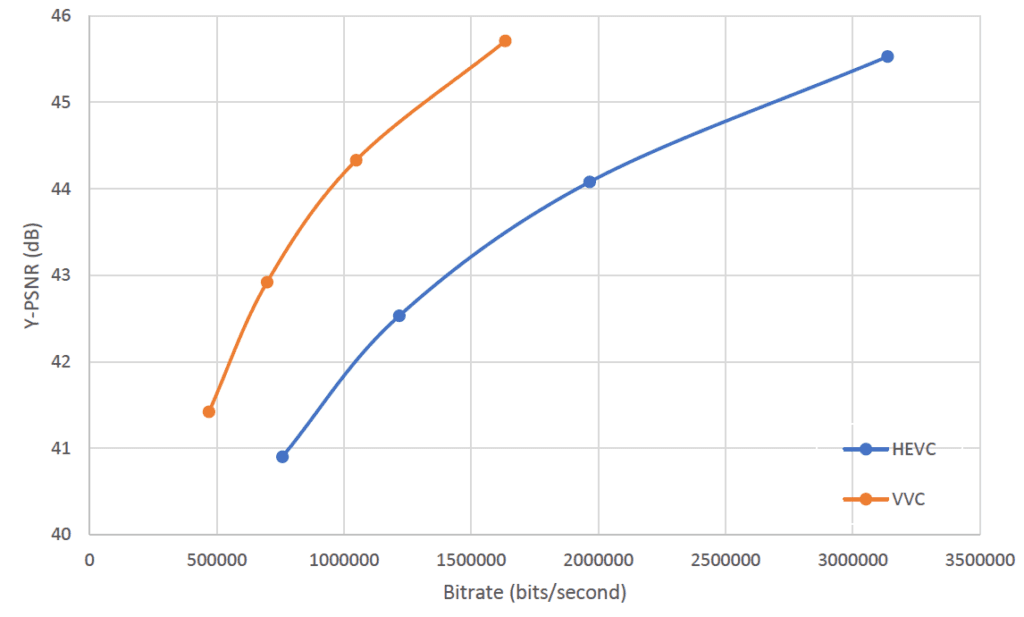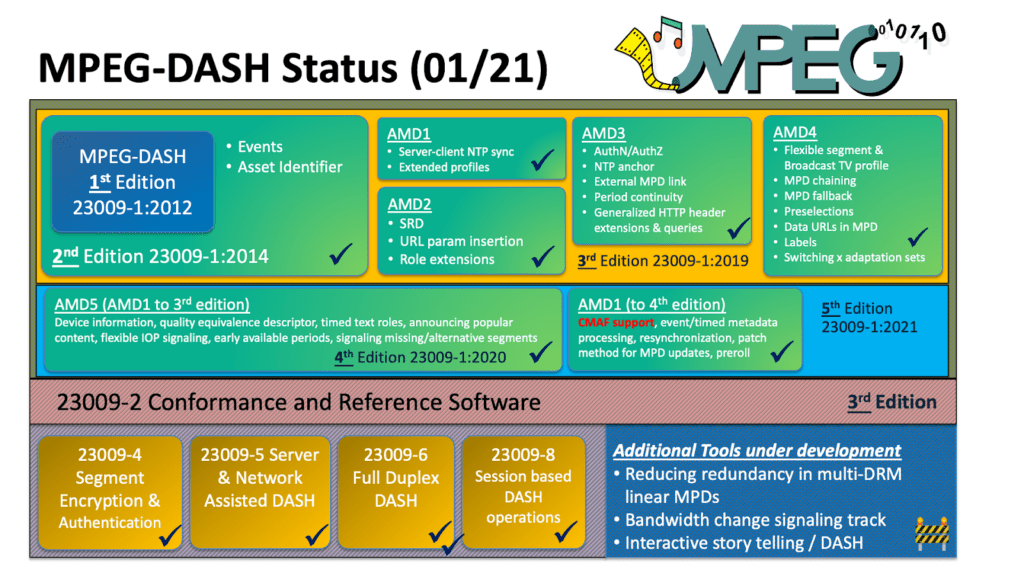Preface
Bitmovin isn’t the only organization whose sole purpose is to shape the future of video – a few senior developers at Bitmovin along with me are active members of the Moving Pictures Expert Group (MPEG). Personally, I have been a member and attendant of MPEG for 15+ years and have been documenting the progress since early 2010. The 133rd MPEG meeting was officially the 4th consecutive virtual working group, officially marking a full year of online-only developments in video standardization. Although in-person meetings are highly effective, I’ve found that our new segmented process is proving just as productive virtually as it was when we were all together. Amongst the many innovations that this year has yielded, the 133rd MPEG meeting has once again made great leaps in the field of video standardization with further development of the EVC codec, new VVC codec milestones, and even an Emmy® Award.
The 133rd MPEG Meeting Makes Significant Progress in the Face of Adversity
The 133rd MPEG meeting was once again held as an online meeting, and this time, kicked off with great news, that MPEG is one of the organizations honored as a 72nd Annual Technology & Engineering Emmy® Awards Recipient, specifically the MPEG Systems File Format Subgroup and its ISO Base Media File Format (ISOBMFF) et al.
The official press release can be found here and comprises the following items:
- 6th Emmy® Award for MPEG Technology: MPEG Systems File Format Subgroup wins Technology & Engineering Emmy® Award
- Essential Video Coding (EVC) verification test finalized
- MPEG issues a Call for Evidence on Video Coding for Machines
- Neural Network Compression for Multimedia Applications – MPEG calls for technologies for incremental coding of neural networks
- MPEG Systems reaches the first milestone for supporting Versatile Video Coding (VVC) and Essential Video Coding (EVC) in the Common Media Application Format (CMAF)
- MPEG Systems continuously enhances Dynamic Adaptive Streaming over HTTP (DASH)
- MPEG Systems reached the first milestone to carry event messages in tracks of the ISO Base Media File Format
In this report, I’d like to focus on ISOBMFF, EVC, CMAF, and DASH.
MPEG Systems File Format Subgroup wins Technology & Engineering Emmy® Award
MPEG is pleased to report that the File Format subgroup of MPEG Systems is being recognized this year by the National Academy for Television Arts and Sciences (NATAS) with a Technology & Engineering Emmy® for their 20 years of work on the ISO Base Media File Format (ISOBMFF). This format was first standardized in 1999 as part of the MPEG-4 Systems specification and is now in its 6th edition as ISO/IEC 14496-12. It has been used and adopted by many other specifications, e.g.:
- MP4 and 3GP file formats;
- Carriage of NAL unit structured video in the ISO Base Media File Format which provides support for AVC, HEVC, VVC, EVC, and probably soon LCEVC;
- MPEG-21 file format;
- Dynamic Adaptive Streaming over HTTP (DASH) and Common Media Application Format (CMAF);
- High-Efficiency Image Format (HEIF);
- Timed text and other visual overlays in ISOBMFF;
- Common encryption format;
- Carriage of timed metadata metrics of media;
- Derived visual tracks;
- Event message track format;
- Carriage of uncompressed video;
- Omnidirectional Media Format (OMAF);
- Carriage of visual volumetric video-based coding data;
- Carriage of geometry-based point cloud compression data;
- … to be continued!
This is MPEG’s fourth Technology & Engineering Emmy® Award (after MPEG-1 and MPEG-2 together with JPEG in 1996, Advanced Video Coding (AVC) in 2008, and MPEG-2 Transport Stream in 2013) and sixth overall Emmy® Award including the Primetime Engineering Emmy® Awards for Advanced Video Coding (AVC) High Profile in 2008 and High-Efficiency Video Coding (HEVC) in 2017, respectively.
In addition, Bitmovin, a highly involved contributor and tester of MPEG’s work was awarded an Emmy® for its Development of Massive Processing Optimized Compression Technologies.
Essential Video Coding (EVC) verification test finalized
At the 133rd MPEG meeting, a verification testing assessment of the Essential Video Coding (EVC) standard was completed. The first part of the EVC verification test using high dynamic range (HDR) and wide color gamut (WCG) was completed at the 132nd MPEG meeting. A subjective quality evaluation was conducted comparing the EVC Main profile to the HEVC Main 10 profile and the EVC Baseline profile to AVC High 10 profile, respectively:
- Analysis of the subjective test results showed that the average bitrate savings for EVC Main profile are approximately 40% compared to HEVC Main 10 profile, using UHD and HD SDR content encoded in both random access and low delay configurations.
- The average bitrate savings for the EVC Baseline profile compared to the AVC High 10 profile is approximately 40% using UHD SDR content encoded in the random-access configuration and approximately 35% using HD SDR content encoded in the low delay configuration.
- Verification test results using HDR content had shown average bitrate savings for EVC Main profile of approximately 35% compared to HEVC Main 10 profile.
By providing significantly improved compression efficiency compared to HEVC and earlier video coding standards while encouraging the timely publication of licensing terms, the MPEG-5 EVC standard is expected to meet the market needs of emerging delivery protocols and networks, such as 5G, enabling the delivery of high-quality video services to an ever-growing audience.
In addition to verification tests, EVC, along with VVC and CMAF were subject to further improvements to their support systems.
MPEG Systems reaches the first milestone for supporting Versatile Video Coding (VVC) and Essential Video Coding (EVC) in the Common Media Application Format (CMAF)
At the 133rd MPEG meeting, MPEG Systems promoted Amendment 2 of the Common Media Application Format (CMAF) to Committee Draft Amendment (CDAM) status, the first major milestone in the ISO/IEC approval process. This amendment defines:
- constraints to (i) Versatile Video Coding (VVC) and (ii) Essential Video Coding (EVC) video elementary streams when carried in a CMAF video track;
- codec parameters to be used for CMAF switching sets with VVC and EVC tracks; and
- support of the newly introduced MPEG-H 3D Audio profile.
It is expected to reach its final milestone in early 2022.
Bitmovin was one of the first adopters of CMAF (see here and here) and recently evaluated the base VVC encoder, VTM against the HEVC codec. Investigating and evaluating new formats or extensions of existing formats is very important for future applications and services aiming at improving the end user’s Quality of Experience (QoE).

MPEG Systems continuously enhances Dynamic Adaptive Streaming over HTTP (DASH)
At the 133rd MPEG meeting, MPEG Systems promoted Part 8 of Dynamic Adaptive Streaming over HTTP (DASH) also referred to as “Session-based DASH” to its final stage of standardization (i.e., Final Draft International Standard (FDIS)).
Historically, in DASH, every client uses the same Media Presentation Description (MPD), as it best serves the scalability of the service. However, there have been increasing requests from the industry to enable customized manifests for enabling personalized services. MPEG Systems has standardized a solution to this problem without sacrificing scalability. Session-based DASH adds a mechanism to the MPD to refer to another document, called Session-based Description (SBD), which allows per-session information. The DASH client can use this information (i.e., variables and their values) provided in the SBD to derive the URLs for HTTP GET requests.
An updated overview of DASH standards/features can be found in the Figure below.

The next meeting will be again an online meeting in April 2021.
Click here for more information about MPEG meetings and their developments
A little lost about the formats and standards described above? Check out some other great educational content to learn more!
- Bitmovin’s Video Developer Network (No Sign-up Required!)
- [Blog Post] MPEG 132 Meeting Takeaways
- [Blog Series] Cloud-Agnostic Encoding Solutions for Dolby Vision and Dolby Atmos
- [Blog Series] Super-Resolution with Machine Learning
- [E-Book] Ultimate Guide to Container Formats





